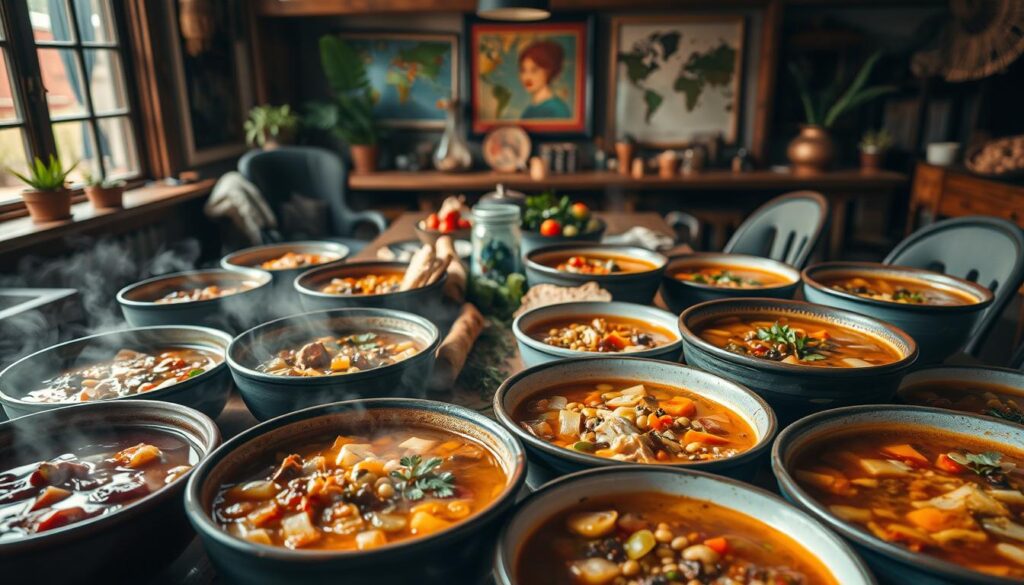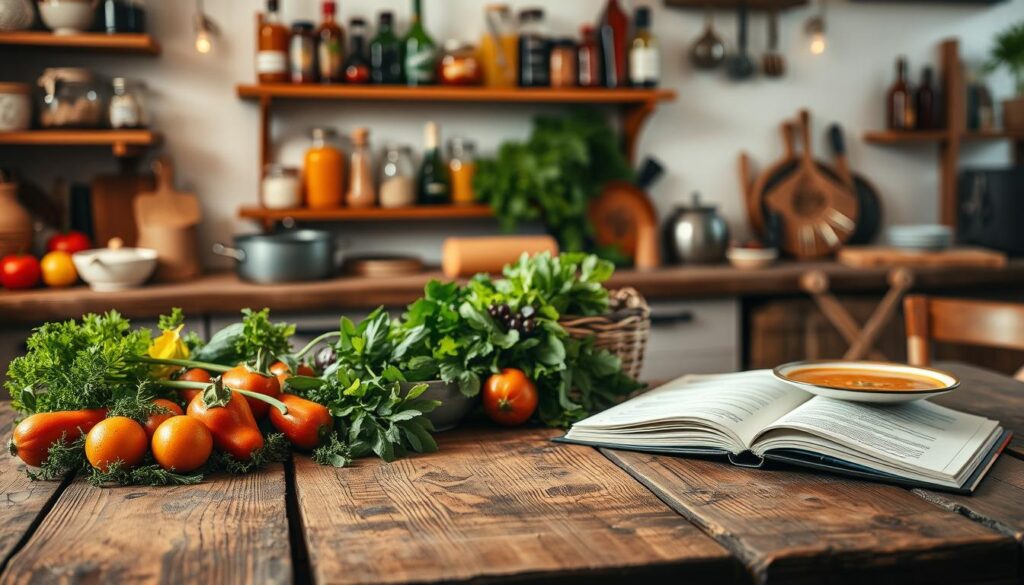As autumn’s cool breeze arrives, nothing warms the heart like a hot bowl of soup. Soup n fresh ingredients turn simple meals into special treats that both comfort and feed us. Imagine stepping into your kitchen, where the scent of fresh ingredients fills the air, promising a tasty journey for your taste buds.
This season offers more than 30 easy soup recipes to change your cooking game. These recipes range from quick 30-minute dishes to big meals for 4-6 people. They celebrate the art of soup making with fresh, seasonal ingredients. Whether you’re always on the go or love cooking at home, these soup n fresh recipes will be your new favorite comfort food.
Key Takeaways
- Discover over 30 delicious soup recipes perfect for fall and winter
- Learn how to use farm-fresh ingredients for maximum flavor
- Explore soups that can be prepared in 30 minutes or less
- Find recipes with an average of 10 ingredients or fewer
- Unlock techniques for freezing and storing homemade soups
Understanding the Art of Homemade Soup Making
Making delicious homemade soups is a key cooking skill. It turns simple ingredients into cozy meals. Your soup-making journey starts with learning basic techniques and choosing the right tools.
Essential Kitchen Equipment for Soup Preparation
To begin your soup-making journey, you’ll need a few important tools:
- A high-quality stockpot with a heavy bottom
- A sharp chef’s knife for chopping ingredients
- An immersion blender for smooth soups
- A cutting board just for veggies
Basic Soup Making Techniques
Learning to make soup involves a few key steps. Start by making a flavorful base with onions and garlic. Your homemade broth will make every soup taste better.
- Sauté veggies until they’re soft (15-20 minutes)
- Add liquid and simmer slowly
- Season as you go
- Check the taste and adjust
The Importance of Fresh Ingredients
Seasonal produce is key to making great soups. Fresh veggies taste better and are healthier. Choose local, in-season ingredients for the best flavor and nutrition.
Pro tip: Always taste your soup and season well. A little salt can make a big difference.
As you practice, your soup-making skills will grow. Remember, each soup is a story of cooking and fresh ingredients.
Classic Chicken Soup Variations
Chicken soup is the ultimate comfort food. It warms both body and soul. From traditional recipes to international twists, there’s something for everyone.
Discover these exciting chicken soup variations. They turn a simple dish into a culinary adventure:
- Classic Chicken Noodle Soup: A timeless favorite with tender chicken, veggies, and soft noodles
- Avgolemono: A Greek twist with lemon and egg for a creamy, tangy taste
- Chicken Tortilla Soup: A spicy Mexican soup with crispy tortilla strips
- Vietnamese Chicken Meatball Soup: A light, aromatic soup with delicate meatballs
Nutrition-conscious cooks will love these recipes. Calories range from 147 to 614 per serving. Protein is between 10g and 57g. Cooking time varies from 25 minutes to nearly 7 hours.
Pro tip: Add fresh herbs like thyme, rosemary, and sage to your chicken soup. They boost flavor and add nutritional benefits.
“A good chicken soup is like a warm hug for your taste buds and your health.” – Chef’s wisdom
Hearty Vegetable Soup Combinations
Making a tasty vegetable medley soup is like creating a work of art. It turns simple ingredients into a nutritious bowl of goodness. Your kitchen becomes a place where colorful vegetables create a healthy masterpiece.
A great vegetable soup is very flexible. You can change it up by swapping out ingredients and trying new veggies.
Seasonal Vegetable Selection Guide
Picking the right veggies is key for a delicious soup. Here are some seasonal choices:
- Spring: Asparagus, peas, artichokes
- Summer: Zucchini, yellow squash, bell peppers
- Fall: Butternut squash, sweet potatoes, carrots
- Winter: Kale, Brussels sprouts, root vegetables
Flavor Enhancement Tips
Here are some ways to make your soup even better:
- Roast your veggies before adding them to the soup for a richer taste
- Use fresh herbs like thyme, rosemary, or basil
- Add a bit of acid (lemon juice or vinegar) to make the flavors pop
- Try spices like cumin, paprika, or curry powder
Storage and Freezing Methods
Keep your soup fresh with these storage tips:
- Refrigerate for up to 4 days in a sealed container
- Freeze for up to 3 months
- Use freezer-safe containers or bags
- Make sure to leave space for expansion when freezing
Your homemade vegetable soup is a healthy treat that you can customize. Enjoy making delicious, nutritious meals!
Creamy Soup n Fresh Recipes for Every Season
Explore the world of slow-simmered flavors with our creamy soup n fresh recipes. They will make your mealtime special. Each season offers unique ingredients for comforting, nutritious soups that please your taste buds.
Learn to make creamy soups that highlight seasonal produce. These soups range from light summer recipes to hearty winter ones. There’s something for every taste.
Seasonal Creamy Soup Highlights
- Summer: Creamy Tomato Basil Soup – Fresh tomatoes blended to perfection
- Fall: Butternut Squash Soup – Roasted squash with warming spices
- Winter: Potato Leek Soup – Smooth and comforting
- Spring: Chilled Cucumber Soup – Refreshing and light
Creating creamy soups doesn’t have to take a lot of time. With smart techniques and fresh ingredients, you can make restaurant-quality soups at home.
| Soup Type | Calories/Cup | Preparation Time | Servings |
|---|---|---|---|
| Creamy Tomato Basil | 210 | 30 minutes | 4-6 |
| Butternut Squash | 160 | 45 minutes | 6-8 |
| Potato Leek | 250 | 40 minutes | 4-5 |
| Chilled Cucumber | 136 | 20 minutes | 3-4 |
“A great soup is like a warm hug for your taste buds – comforting, nourishing, and always welcome.” – Chef Maria Rodriguez
Try different bases for your creamy soups. Use cashew cream, coconut milk, or heavy cream to find your favorite. There’s a method for every dietary need.
Artisanal Broths and Stock Foundations
Making artisanal broths is key for home cooks wanting to improve their soups. Homemade broth adds depth and richness that store-bought can’t. It’s the base of great soups.
To make perfect homemade broth, focus on details and learn important techniques. Here are essential steps for making amazing broths:
- Select high-quality bones or vegetable scraps
- Use the right water-to-ingredient ratio (approximately 15 cups)
- Incorporate flavor enhancers like apple cider vinegar
- Maintain a gentle simmering temperature
Bone Broth Preparation
Bone broth is an art that turns simple ingredients into a rich liquid. For chicken stock, follow these expert tips:
- Use 1.5 to 2 pounds of chicken carcass
- Simmer for 3 to 12 hours
- Add whole peppercorns (1 teaspoon per batch)
- Include a bay leaf for additional depth
Vegetable Stock Basics
Vegetable stocks are a great choice for those who prefer plant-based options. Use leftover vegetable scraps to make a flavorful base. It captures the essence of your ingredients.
Storing and Using Homemade Broths
Storing broths right is key to keeping their quality. Refrigerate for up to 4 days or freeze for 3 months. When freezing, leave space at the top for expansion.
Pro tip: Homemade broth lets you control flavor and nutrition.
By learning these techniques, you’ll make your soups stand out. You’ll create memorable meals that show off the best of artisanal broths.
International Soup Inspirations

Start a culinary journey through hearty soups from around the world. Each place has its own special recipes. These turn seasonal produce into unforgettable meals.
Discover the exciting soup traditions from different countries. They will help you grow your cooking skills:
- Spanish Gazpacho: A cool tomato soup for hot summer days
- Russian Borscht: A hearty beetroot soup with a long history
- Thai Tom Kha Gai: A coconut chicken soup full of flavors
- Japanese Miso Soup: A light broth with deep umami flavors
Cultures worldwide show amazing creativity in making soups. From spicy broths in Southeast Asia to thick stews in Eastern Europe. Each dish uses local ingredients and cooking ways.
| Soup Origin | Key Ingredients | Preparation Time |
|---|---|---|
| Vietnamese Phở | Rice noodles, beef, herbs | 45-60 minutes |
| Indian Rasam | Tamarind, tomatoes, spices | 20-30 minutes |
| Mexican Pozole | Hominy, pork, chili peppers | 2-3 hours |
When making international soups, use fresh, seasonal ingredients. This brings out the true flavors. Try local ingredients and traditional cooking methods for meals you’ll always remember.
Quick and Easy 30-Minute Soup Recipes
Busy weeknights need fast and tasty soup recipes. Our 30-minute soups are quick and comforting. You can make mealtime less stressful with these 10 fast recipes.
Time-Saving Preparation Tips
Make soup-making quicker with these tips:
- Use pre-cut vegetables from the grocery store
- Leverage rotisserie chicken for instant protein
- Keep frozen vegetables in your freezer
- Invest in quality kitchen tools like immersion blenders
Ingredient Shortcuts
Choose smart ingredients for faster cooking and great taste. Try these soup n fresh tips:
- Canned beans for instant protein
- Frozen potstickers as a quick soup base
- Pre-made freezer meatballs
- Jarred minced garlic
Make-Ahead Options
Meal prep is easy with these soups. Four of our recipes can be completely frozen for later. They’re ready in 25 minutes on average, with some in just 15 minutes.
Pro tip: When freezing soups, separate liquid from noodles to prevent mushiness upon thawing.
Enjoy quick, healthy soups that fit your busy life!
Healthy and Nutritious Soup Options
Discover the power of wholesome nourishment through delicious soup recipes. These soups pack a nutritional punch. Farm-fresh ingredients are the secret to creating soups that taste amazing and support your health and wellness.
When crafting nutritious soups, focus on ingredients that maximize nutritional value. Consider these key strategies for building incredibly healthy soup options:
- Incorporate lean proteins like chicken, turkey, or plant-based alternatives
- Add nutrient-dense vegetables for extra vitamins and minerals
- Use whole grains to increase fiber content
- Experiment with legumes for additional protein and sustained energy
Nutritional research shows impressive health benefits from carefully selected soup ingredients. A single serving of well-crafted soup can provide:
| Nutrient | Average Range |
|---|---|
| Protein | 10-25g per serving |
| Fiber | 5-10g per serving |
| Calories | 80-392 calories |
“Food is not just fuel, it’s information. Choose ingredients that speak to your body’s nutritional needs.” – Nutrition Expert
Your journey to healthier eating starts with smart soup choices. By prioritizing farm-fresh ingredients and understanding nutritional balance, you can transform simple soups into powerful meals. These meals nourish both body and soul.
Garnishing and Presentation Techniques
Turning your soup n fresh recipes into something special is all about garnishing and presentation. The way food looks can really affect how we enjoy it. In fact, 70% of diners say presentation is key to a great dining experience.

Professional chefs know garnishing is more than just a pretty face. It’s about making a meal that touches all our senses. This turns simple ingredients into culinary wonders.
Creative Toppings that Wow
Here are some fun garnishing ideas to make your soups pop:
- Fresh herbs, used by over 85% of chefs, add flavor and look
- Microgreens from radish and broccoli sprouts, a favorite of 40% of chefs
- Edible flowers like nasturtiums, used by 30% of chefs for a fancy touch
- Crispy elements like tortilla chips or croutons for a nice crunch
Plating for Maximum Visual Impact
The way you present your soup can make or break the meal. Here are some pro tips:
| Technique | Usage Percentage | Effect |
|---|---|---|
| Vertical Layering | 35% | Creates eye-catching arrangements |
| Sauce Smearing | 75% | Dramatic visual effect |
| Contrasting Colors | 65% | Enhances visual appeal |
“Great garnishing is about telling a story on the plate” – Professional Chef
Try using citrus zest, unique salt blends, and creative sauces. This will turn your soup n fresh recipes into stunning dishes that impress everyone.
Seasonal Soup and Fresh Ingredient Pairings
Take your soup game to the next level by learning about seasonal produce pairing. Using fresh, farm ingredients turns simple soups into amazing dishes. These dishes celebrate the unique tastes of each season.
Knowing how to pick seasonal ingredients can make your soups better. The trick is to pair fresh, local produce with herbs and spices. This brings out the best in each flavor.
- Spring soups: Use fresh peas, asparagus, and tender herbs like mint
- Summer soups: Emphasize ripe tomatoes, sweet corn, and fresh basil
- Fall soups: Focus on butternut squash, apples, and warming spices
- Winter soups: Choose root vegetables, hearty greens, and robust seasonings
Chefs know that 70% of today’s customers want fresh, local ingredients. Choosing seasonal produce boosts flavor. It also helps local farmers and saves money on ingredients.
“Seasonal ingredients are the secret weapon of exceptional home cooking.” – Chef Margaret Wilson
Pro tip: Check out local farmers markets for the freshest produce. Your taste buds and local farmers will appreciate it!
Tips for Perfect Soup Consistency
Making the perfect soup is an art that turns simple recipes into amazing dishes. It’s all about how ingredients change and mix during cooking. Chefs know that the feel of a soup is just as key as its taste.
Here are key techniques for getting the right soup consistency:
- Use split peas as a natural thickening agent
- Incorporate artisanal broths for rich base flavors
- Control liquid-to-ingredient ratios carefully
- Experiment with different thickening methods
Managing soup thickness needs smart strategies. Cornstarch slurries can fix soups that are too thin. Start with ¼ cup cornstarch and ¼ cup stock for 8 cups of soup. Kitchens often save some liquid before blending to keep the soup just right.
| Technique | Purpose | Recommended Method |
|---|---|---|
| Puréeing | Smooth texture | Use powerful blender, strain through fine mesh |
| Thickening | Increase density | Add cornstarch, pureed vegetables, legumes |
| Thinning | Reduce density | Add broth or water gradually |
Seasoning is key to deepening flavors. Chefs say to add salt at different times to boost the taste. Your aim is to blend texture and taste perfectly in every bite.
Conclusion
Your journey in soup making is more than cooking. It’s a tasty adventure of flavors, health, and warmth. Soup n fresh recipes let you mix simple ingredients into meals that feed both body and soul.
The art of making soup is more than just cooking. You might make a classic chicken soup or try blackeye pea recipes. Each soup tells a special story. Comforting meals are about more than taste; they’re about connecting with your food, learning new skills, and showing your love for cooking.
Keep exploring in your soup-making journey. Be flexible with ingredients and try new things. Use seasonal foods, mix spices, and make each soup your own. Your next soup could become a family hit or a special memory.
At its heart, soup making is an art that lets you express yourself. With every spoonful, you’re not just serving food. You’re creating a moment of joy, health, and togetherness at the table.



